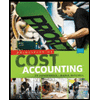White Company has two departments, Cutting and Finishing. The company uses a job-order costing system and computes a predetermined overhead rate in each department. The Cutting Department bases its rate on machine-hours, and the Finishing Department bases its rate on direct labor-hours. At the beginning of the year, the company made the following estimates: Department Direct labor-hours Machine-hours Total fixed manufacturing overhead cost Variable manufacturing overhead per machine-hour Variable manufacturing overhead per direct labor-hour Direct labor-hours. Machine-hours Direct materials. Direct labor cost Required: 1. Compute the predetermined overhead rate for each department. 2. The job cost sheet for Job 203, which was started and completed during the year, showed the following: Department Cutting 4 87 $ 770 $80 Finishing 11 4 Required 1 Required 2 Cutting 8,800 56,000 $ 370 $ 220 $360,000 $ 3.00 Required 3 Finishing 90,000 2,300 $ 598,000 $ 4.75 Using the predetermined overhead rates that you computed in requirement (1), compute the total manufacturing cost assigned to Job 203. 3. Would you expect substantially different amounts of overhead cost to be assigned to some jobs if the company used a plantwide predetermined overhead rate based on direct labor-hours, rather than using departmental rates? Complete the question by entering your answers in the tabs given below. Compute the predetermined overhead rate for each department. (Round your answers to 2 decimal places.)
White Company has two departments, Cutting and Finishing. The company uses a job-order costing system and computes a predetermined overhead rate in each department. The Cutting Department bases its rate on machine-hours, and the Finishing Department bases its rate on direct labor-hours. At the beginning of the year, the company made the following estimates: Department Direct labor-hours Machine-hours Total fixed manufacturing overhead cost Variable manufacturing overhead per machine-hour Variable manufacturing overhead per direct labor-hour Direct labor-hours. Machine-hours Direct materials. Direct labor cost Required: 1. Compute the predetermined overhead rate for each department. 2. The job cost sheet for Job 203, which was started and completed during the year, showed the following: Department Cutting 4 87 $ 770 $80 Finishing 11 4 Required 1 Required 2 Cutting 8,800 56,000 $ 370 $ 220 $360,000 $ 3.00 Required 3 Finishing 90,000 2,300 $ 598,000 $ 4.75 Using the predetermined overhead rates that you computed in requirement (1), compute the total manufacturing cost assigned to Job 203. 3. Would you expect substantially different amounts of overhead cost to be assigned to some jobs if the company used a plantwide predetermined overhead rate based on direct labor-hours, rather than using departmental rates? Complete the question by entering your answers in the tabs given below. Compute the predetermined overhead rate for each department. (Round your answers to 2 decimal places.)
Cornerstones of Cost Management (Cornerstones Series)
4th Edition
ISBN:9781305970663
Author:Don R. Hansen, Maryanne M. Mowen
Publisher:Don R. Hansen, Maryanne M. Mowen
Chapter4: Activity-based Costing
Section: Chapter Questions
Problem 30P: Primera Company produces two products and uses a predetermined overhead rate to apply overhead....
Related questions
Question
s

Transcribed Image Text:White Company has two departments, Cutting and Finishing. The company uses a job-order costing system and computes a
predetermined overhead rate in each department. The Cutting Department bases its rate on machine-hours, and the Finishing
Department bases its rate on direct labor-hours. At the beginning of the year, the company made the following estimates:
Department
Direct labor-hours
Machine-hours
Total fixed manufacturing overhead cost
Variable manufacturing overhead per machine-hour
Variable manufacturing overhead per direct labor-hour
Direct labor-hours
Machine-hours
Direct materials
Direct labor cost
Required:
1. Compute the predetermined overhead rate for each department.
2. The job cost sheet for Job 203, which was started and completed during the year, showed the following:
Department
Cutting
4
87
$ 770
$ 80
Finishing
11
4
Required 1 Required 2
Cutting
8,800
56,000
$ 370
$ 220
$360,000
$ 3.00
Required 3
Finishing
90,000
2,300
$ 598,000
$4.75
Using the predetermined overhead rates that you computed in requirement (1), compute the total manufacturing cost assigned to Job
203.
3. Would you expect substantially different amounts of overhead cost to be assigned to some jobs if the company used a plantwide
predetermined overhead rate based on direct labor-hours, rather than using departmental rates?
Complete the question by entering your answers in the tabs given below.
Compute the predetermined overhead rate for each department. (Round your answers to 2 decimal places.)
Expert Solution
This question has been solved!
Explore an expertly crafted, step-by-step solution for a thorough understanding of key concepts.
This is a popular solution!
Trending now
This is a popular solution!
Step by step
Solved in 5 steps

Knowledge Booster
Learn more about
Need a deep-dive on the concept behind this application? Look no further. Learn more about this topic, accounting and related others by exploring similar questions and additional content below.Recommended textbooks for you

Cornerstones of Cost Management (Cornerstones Ser…
Accounting
ISBN:
9781305970663
Author:
Don R. Hansen, Maryanne M. Mowen
Publisher:
Cengage Learning

Principles of Cost Accounting
Accounting
ISBN:
9781305087408
Author:
Edward J. Vanderbeck, Maria R. Mitchell
Publisher:
Cengage Learning

Managerial Accounting
Accounting
ISBN:
9781337912020
Author:
Carl Warren, Ph.d. Cma William B. Tayler
Publisher:
South-Western College Pub

Cornerstones of Cost Management (Cornerstones Ser…
Accounting
ISBN:
9781305970663
Author:
Don R. Hansen, Maryanne M. Mowen
Publisher:
Cengage Learning

Principles of Cost Accounting
Accounting
ISBN:
9781305087408
Author:
Edward J. Vanderbeck, Maria R. Mitchell
Publisher:
Cengage Learning

Managerial Accounting
Accounting
ISBN:
9781337912020
Author:
Carl Warren, Ph.d. Cma William B. Tayler
Publisher:
South-Western College Pub

Financial And Managerial Accounting
Accounting
ISBN:
9781337902663
Author:
WARREN, Carl S.
Publisher:
Cengage Learning,

Principles of Accounting Volume 2
Accounting
ISBN:
9781947172609
Author:
OpenStax
Publisher:
OpenStax College